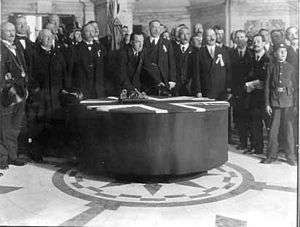Ulster Covenant


The Ulster Covenant, also known as Ulster's Solemn League and Covenant, was signed by just under half a million men and women from Ulster, on and before 28 September 1912, in protest against the Third Home Rule Bill, introduced by the British Government in that same year. Sir Edward Carson was the first person to sign the Covenant at the Belfast City Hall with a silver pen,[1] followed by Lord Londonderry (the former viceroy of Ireland), representatives of the Protestant churches, and then by Sir James Craig. The signatories, 471,414 in all,[2] were all against the establishment of a Home Rule parliament in Dublin. The Ulster Covenant is immortalised in Rudyard Kipling's poem "Ulster 1912".
The Covenant had two basic parts: the Covenant itself, which was signed by men, and the Declaration, which was signed by women. In total, the Covenant was signed by 237,368 men; the Declaration, by 234,046 women. Both the Covenant and Declaration are held by the Public Record Office of Northern Ireland (PRONI). An online searchable database is available on the PRONI website.

In January 1913, the Ulster Volunteers aimed to recruit 100,000 men aged from 17 to 65 who had signed the Covenant, as a unionist militia.[3]
A British Covenant, similar to the Ulster Covenant in opposition to the Home Rule Bill, received two million signatures in 1914.
Signed in blood myth
The signature of Frederick Hugh Crawford was claimed by him to have been written in blood. However, based on the results of a forensic test that he carried out in September 2012 at PRONI, Dr. Alastair Ruffell of The Queen's University of Belfast has asserted that he is 90% positive that the signature is not blood. Crawford's signature was injected with a small amount of luminol; this substance reacts with iron in blood's haemoglobin to produce a blue-white glow. The test is very sensitive and can detect tiny traces even in old samples. Crawford's signature is still a rich red colour today which would be unlikely if it had been blood. Nevertheless, some unionists are not convinced by the evidence.[4]
The Covenant (for men)
BEING CONVINCED in our consciences that Home Rule would be disastrous to the material well-being of Ulster as well as of the whole of Ireland, subversive of our civil and religious freedom, destructive of our citizenship, and perilous to the unity of the Empire, we, whose names are underwritten, men of Ulster, loyal subjects of His Gracious Majesty King George V., humbly relying on the God whom our fathers in days of stress and trial confidently trusted, do hereby pledge ourselves in solemn Covenant, throughout this our time of threatened calamity, to stand by one another in defending, for ourselves and our children, our cherished position of equal citizenship in the United Kingdom, and in using all means which may be found necessary to defeat the present conspiracy to set up a Home Rule Parliament in Ireland. And in the event of such a Parliament being forced upon us, we further solemnly and mutually pledge ourselves to refuse to recognise its authority. In sure confidence that God will defend the right, we hereto subscribe our names.
And further, we individually declare that we have not already signed this Covenant.
The Declaration (for women)
We, whose names are underwritten, women of Ulster, and loyal subjects of our gracious King, being firmly persuaded that Home Rule would be disastrous to our Country, desire to associate ourselves with the men of Ulster in their uncompromising opposition to the Home Rule Bill now before Parliament, whereby it is proposed to drive Ulster out of her cherished place in the Constitution of the United Kingdom, and to place her under the domination and control of a Parliament in Ireland.
Praying that from this calamity God will save Ireland, we here to subscribe our names.
Solemn League and Covenant
The term "Solemn League and Covenant" recalled a key historic document signed in 1643, by which the Scottish Covenanters made a political and military alliance with the leaders of the English Parliamentarians during the First English Civil War.
Natal Covenant
The Ulster Covenant was used as a template for the "Natal Covenant", signed in 1955 by 33,000 British-descended Natalians against the nationalist South African government's intention of declaring the Union a republic. It was signed in Durban's City Hall – itself loosely based on Belfast's, so that the Ulster scene was almost exactly reproduced.[5]


Being convinced in our consciences that a republic would be disastrous to the material well-being of Natal as well as of the whole of South Africa, subversive of our freedom and destructive of our citizenship, we, whose names are underwritten, men and women of Natal, loyal subjects of Her Gracious Majesty Queen Elizabeth the Second, do hereby pledge ourselves in solemn covenant, throughout this our time of threatened calamity, to stand by one another in defending the Crown, and in using all means which may be found possible and necessary to defeat the present intention to set up a republic in South Africa. And in the event of a republic being forced upon us, we further solemnly and mutually pledge ourselves to refuse to recognise its authority. In sure confidence that God will defend the right, we hereto subscribe our names. GOD SAVE THE QUEEN.
References
- ↑ PRONI. "The Ulster Covenant: Ulster Day". Retrieved 29 September 2012.
- ↑ PRONI – Historical Topics Series: 5
- ↑ "Ulster Volunteer Force". South Belfast Friends of the Somme Association. Retrieved 29 September 2012.
- ↑ "Fred Crawford 'blood signature' legend challenged". BBC News Website. 27 September 2012. Retrieved 29 September 2012.
- ↑ Jeffery, Keith (1996). An Irish Empire?: Aspects of Ireland and the British Empire. Manchester University Press. pp. 199–201.
External links
- BBC History – Ulster Covenant
- Friends of the Somme – Ulster Loyalty
- Ulster 1912 by Rudyard Kipling on Wikisource